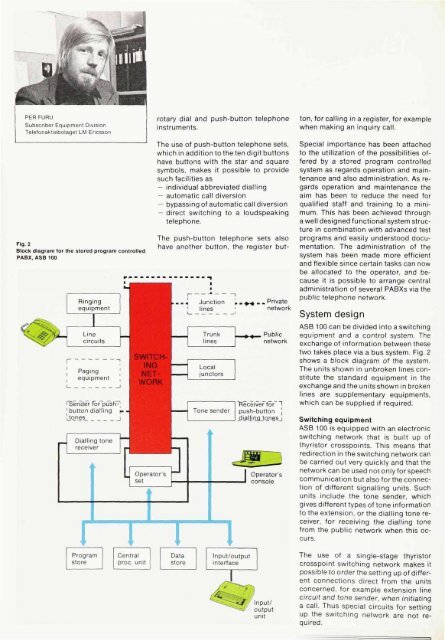ericsson review - ericssonhistory.com
ericsson review - ericssonhistory.com
ericsson review - ericssonhistory.com
You also want an ePaper? Increase the reach of your titles
YUMPU automatically turns print PDFs into web optimized ePapers that Google loves.
PER FURU<br />
Subscriber Equipment Division<br />
Telefonaktiebolaget LM Ericsson<br />
Fig. 2<br />
Block diagram for the stored program controlled<br />
PABX, ASB100<br />
rotary dial and push-button telephone<br />
instruments.<br />
The use of push-button telephone sets,<br />
which in addition to the ten digit buttons<br />
have buttons with the star and square<br />
symbols, makes it possible to provide<br />
such facilities as<br />
- individual abbreviated dialling<br />
- automatic call diversion<br />
- bypassing of automatic call diversion<br />
- direct switching to a loudspeaking<br />
telephone.<br />
The push-button telephone sets also<br />
have another button, the register button,<br />
for calling in a register, for example<br />
when making an inquiry call.<br />
Special importance has been attached<br />
to the utilization of the possibilities offered<br />
by a stored program controlled<br />
system as regards operation and maintenance<br />
and also administration. As regards<br />
operation and maintenance the<br />
aim has been to reduce the need for<br />
qualified staff and training to a minimum.<br />
This has been achieved through<br />
a well designed functional system structure<br />
in <strong>com</strong>bination with advanced test<br />
programs and easily understood documentation.<br />
The administration of the<br />
system has been made more efficient<br />
and flexible since certain tasks can now<br />
be allocated to the operator, and because<br />
it is possible to arrange central<br />
administration of several PABXs via the<br />
public telephone network.<br />
System design<br />
ASB 100 can be divided into a switching<br />
equipment and a control system. The<br />
exchange of information between these<br />
two takes place via a bus system. Fig. 2<br />
shows a block diagram of the system.<br />
The units shown in unbroken lines constitute<br />
the standard equipment in the<br />
exchange and the units shown in broken<br />
lines are supplementary equipments,<br />
which can be supplied if required.<br />
Switching equipment<br />
ASB 100 is equipped with an electronic<br />
switching network that is built up of<br />
thyristor crosspoints. This means that<br />
redirection in the switching network can<br />
be carried out very quickly and that the<br />
network can be used not only for speech<br />
<strong>com</strong>munication but also for the connection<br />
of different signalling units. Such<br />
units include the tone sender, which<br />
gives different types of tone information<br />
to the extension, or the dialling tone receiver,<br />
for receiving the dialling tone<br />
from the public network when this occurs.<br />
The use of a single-stage thyristor<br />
crosspoint switching network makes it<br />
possible to order the setting up of different<br />
connections direct from the units<br />
concerned, for example extension line<br />
circuit and tone sender, when initiating<br />
a call. Thus special circuits for setting<br />
up the switching network are not required.
















